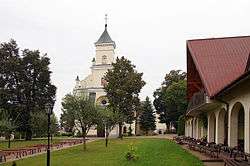Bełżyce
Bełżyce [bɛu̯ˈʐɨt͡sɛ] (![]()
Bełżyce | |
|---|---|
 Church of the Conversion of Saint Paul | |
 Flag  Coat of arms | |
 Bełżyce | |
| Coordinates: 51°11′N 22°16′E | |
| Country | |
| Voivodeship | Lublin Voivodeship |
| County | Lublin County |
| Gmina | Bełżyce |
| Town rights | 1417–1869, 1958 |
| Government | |
| • Mayor | Ireneusz Paweł Łucka[1] |
| Area | |
| • Total | 23.46 km2 (9.06 sq mi) |
| Population (2017[1]) | |
| • Total | 6,591 |
| • Density | 280/km2 (730/sq mi) |
| Time zone | UTC+1 (CET) |
| • Summer (DST) | UTC+2 (CEST) |
| Postal code | 24-200 |
| Area code(s) | +48 81 |
| Climate | Dfb |
| Car plates | LUB |
| Website | http://www.belzyce.pl |
History
Middle Ages

Presumably, in the early 13th century, a minor royal castle was in the area of the present city. The building was transferred to local magnates, who provided ability to settle a town according to Magdeburg Rights in 1349. In 1416 town settlement process began and next year king Władysław Jagiełło gave an official document,[2][3] allowing Bełżyce to improve. First, town was populated by farmers, craftsmen, merchants and alcohol producers. A wooden church was built and a Catholic parish of St. Paul's conversion[4] was created. Since 1432, while two new privileges were acquired, major growth has been noticeable – representatives of four religions lived here together. Catholics and Eastern Christians as farmers, Protestant craftsmen, and Jewish merchants.[5] Bełżyce was a private town located in the Lublin Voivodeship, later also in the Lesser Poland Province of the Polish Crown.
Protestant domination
The 16th and 17th centuries were a period of Protestant influence in the area. Bełżyce became a Protestant, Polish Brethren centre of Lesser Poland.[6] In 1558 a Catholic church was given away and transferred into a Protestant one by Andrzej Bzicki, the town mayor. The Protestant “regime” was so well developed that the mayor issued a directive to residents to take part in services under the punishment of fine or even imprisonment. In 1575, an intellectual religious exchange took place between Rabbi Jacob Nachman of Belzyce and Martin Czechowic of Lublin. The next two centuries were a period of permanent religious riot (with Catholic attempt to retake the church in about 1630), the Cossacks assaults while Khmelnytsky’s uprising (massacre of Jews), fires and plagues of cholera and typhoid fever. A new Catholic church was built in 1670 (the old one was given back in 1654[7]) and 113 years later there are no more Protestants in the town, as their church burned in 1783.
Partition period
In 1795, as a result of the Partitions of Poland, Bełżyce was annexed by the Austrian Empire, it became part of the newly established administrative region of West Galicia. Since 1809 it had been in borders of the short-lived Polish Duchy of Warsaw and since 1815 of Congress Poland, later forcibly integrated into Imperial Russia. The 19th century was a period of changes, as a castle was transformed into a distillery.[8] In 1860 the city occupied nearly 950 ha with about 150 buildings. After the January Uprising, as part of anti-Polish repressions Bełżyce was stripped of its town rights, as it later turned out for nearly 100 years. Two major fires affected the city – first, in 1866, which destroyed 25 buildings, second, in 1913. The whole town was almost destroyed; residents formed a fire brigade. In 1917, 3666 people populated the town, mostly Jewish, as a result of the Russian discriminatory regulations.
Interwar Poland
Bełżyce became again part of Poland after the country regained independence in 1918. Administratively it was part of the Lublin Voivodeship.
World War II

During the invasion of Poland in 1939 the town was captured by the Nazi German Army. The Jews from Bełżyce and nearby towns (including Bychawa and Piotrowice) were resettled into a dozen or so houses on Południowa Street (now Tysiąclecia Street) in December 1940. Between 1940 and 1943 there was a ghetto, consisting of Jews from around Poland and abroad. It was called a transit ghetto. The Jews kept in the crowded area of the ghetto were decimated by typhus and the terrible sanitary conditions[9]. On May 22, 1942, 3,000 Jews from the Bełżyce ghetto were sent to Majdanek and Sobibor, where they were put into the gas chambers. Of the 2,100 Jews from the town, only around 35 survived the war. A Torah scroll from 1730 as well as both synagogues were destroyed by the Germans[10]. The Jewish community ceased to exist.
Post-1945
The second half of the 20th century brought little improvements to Bełżyce city. In 1958 town rights were restored. In 1971 “Warmasz” (Warsaw Groceries Machines’ Factory) company opened their branch factory in Bełżyce, later substituted by a creamery equipment factory "Spomasz".[11]
Historic sites
- A castle that was built by the owners of Bełżyce in 1417, captured by the Cossack forces of Bohdan Khmelnytsky in 1648, and, since Second World War, has been used as a dairy farm.
- A late Renaissance Catholic Church of the Conversion of Saint Paul with a Catholic cemetery
- Jewish cemetery established in the 19th century.
- The manor of Brzeziński family, built in the 1840s together with the park complex.
References
- "Bełżyce (lubelskie)". Polska w liczbach (in Polish). Retrieved 23 October 2019.
- Settlement privilege http://www.site.belzyce.pl/index.php?option=com_content&view=article&id=15&Itemid=29
- http://lubelskie.regiopedia.pl/wiki/historia-belzyc-w-skrocie
- http://parafia.belzyce.pl/
- http://www.sztetl.org.pl/pl/article/belzyce/3,historia-miejscowosci/#footnote_0
- Studia z dziejów Bełżyc s.61,63 wyd. Towarzystwo Regionalne Bełżyc (2005)
- http://dir.icm.edu.pl/pl/Slownik_geograficzny/Tom_XV_cz.2/732
- http://dir.icm.edu.pl/pl/Slownik_geograficzny/Tom_I/131
- "Virtual Sztetl". 2018-07-21.
- "Transports to Sobibor". 2018-07-21.
- http://www.spomasz-belzyce.com.pl/
External links

- Official town website
- Satellite photo from Google Maps
- Bełżyce, Poland at JewishGen
